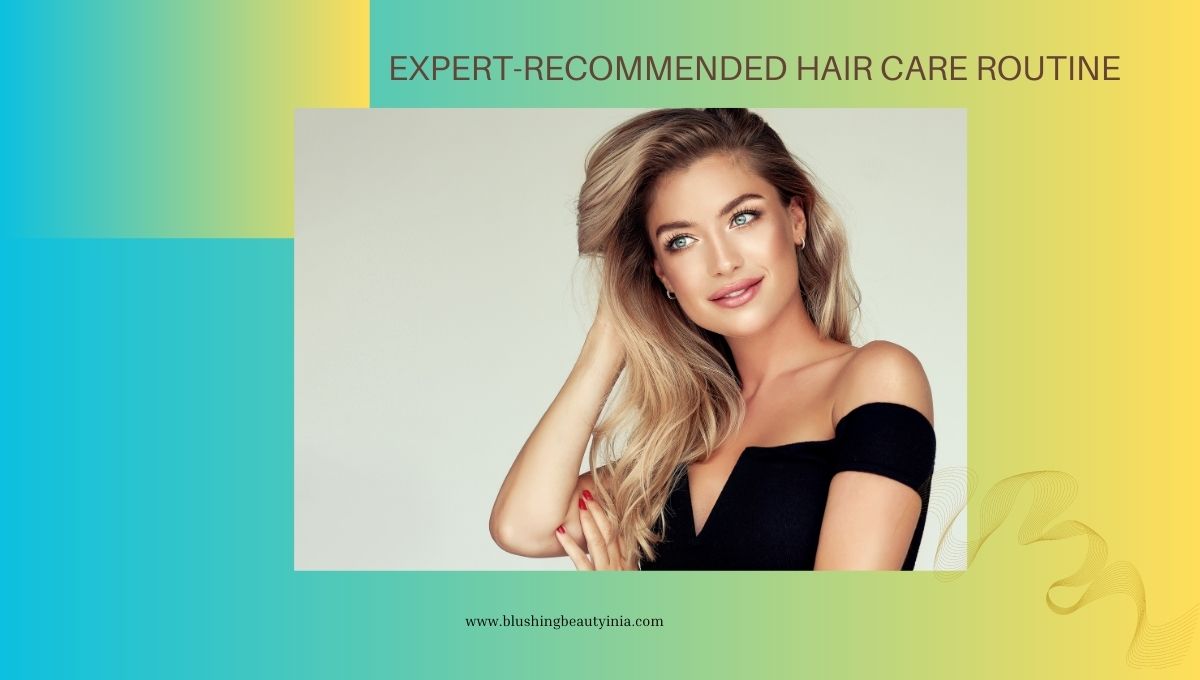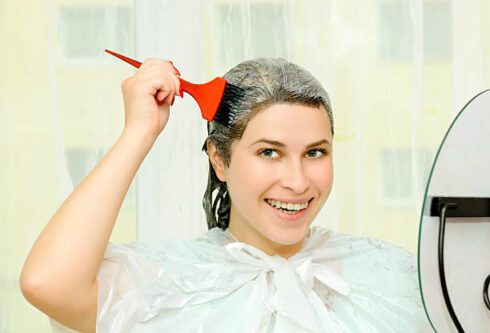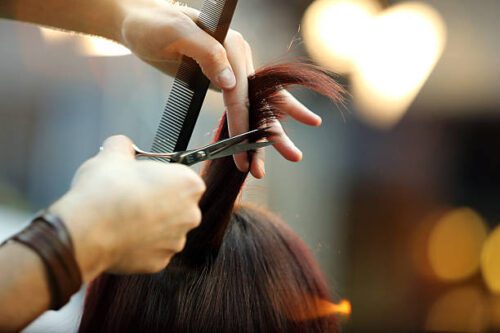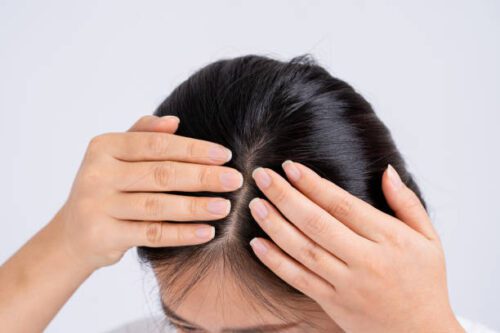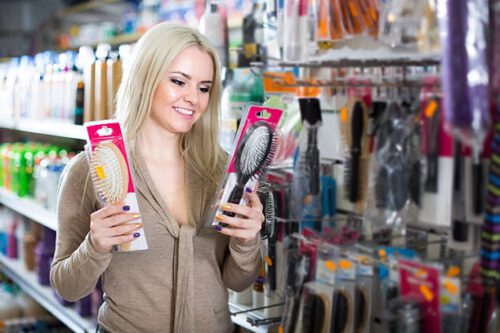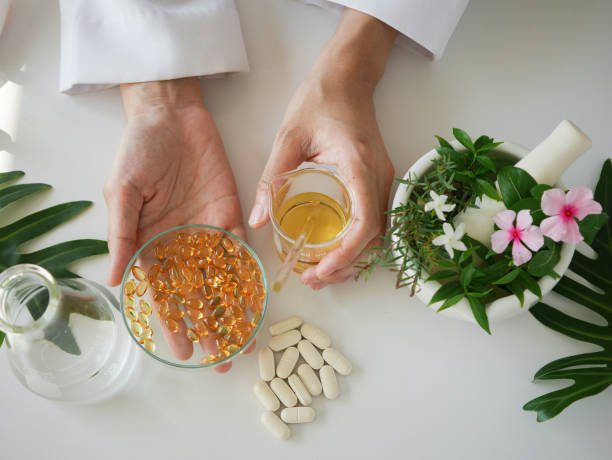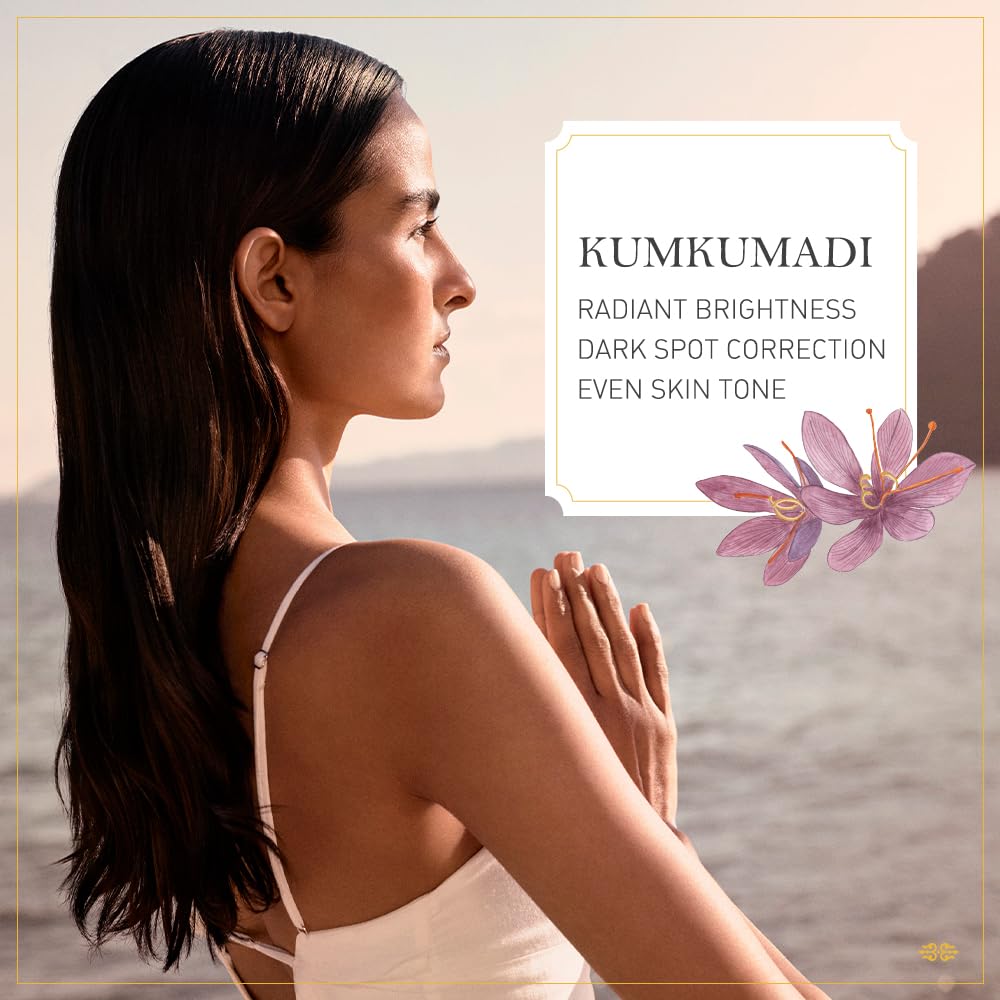Welcome to the comprehensive guide on achieving luscious locks with the Expert-Recommended Hair Care Routine: Tips from a Dermatologist for Healthier, Stronger Hair. Your hair is a reflection of your overall health, and with the right care, you can enjoy vibrant, strong, and stunning hair.
In this article, we’ll delve into the insights and recommendations from a seasoned dermatologist, providing you with a step-by-step routine and valuable advice to maintain the health and beauty of your hair.
1. Understanding Hair Structure and Basics
Hair is a fascinating and intricate part of our body that goes beyond its aesthetic appeal. To truly care for your hair, it’s essential to understand its structure and the basics of how it functions. This knowledge forms the foundation of an effective hair care routine that can lead to healthier and stronger locks.
At its core, hair is composed of a protein called keratin. This protein is built from amino acids, which are the building blocks of life. Understanding this fundamental composition helps us comprehend why certain practices and products benefit our hair more than others.
Hair consists of three main layers: the medulla, cortex, and cuticle. The medulla, found at the centre of the hair shaft, is composed of loosely packed cells. The cortex surrounds the medulla and provides the hair’s strength, colour, and texture. The outermost layer, known as the cuticle, is a protective layer of overlapping cells that shield the inner layers from damage.
Each strand of hair grows from a follicle located in the skin. The hair follicle contains tiny blood vessels that supply nutrients to the hair root, aiding in its growth. An oil gland, called the sebaceous gland, is also attached to each hair follicle. This gland produces sebum, an oily substance that moisturizes the hair and keeps it shiny.
Understanding these structural aspects of hair can guide us in making informed choices when it comes to hair care. For instance, using gentle products that don’t strip away the hair’s natural oils helps maintain the health of the cuticle and prevents damage to the inner layers. Additionally, knowing that the cortex contributes to the hair’s strength emphasizes the importance of protein-rich treatments that can repair and fortify the hair shaft.
Grasping the basics of hair structure enhances our ability to care for our hair effectively. By appreciating the role of proteins, the composition of hair layers, and the function of the hair follicle, we can tailor our hair care routine to address specific needs and achieve the desired results of healthier, stronger, and more beautiful hair.
2. Daily Cleansing with a Gentle Shampoo
Keeping your hair clean is a cornerstone of a successful hair care routine. However, the frequency and choice of shampoo can significantly impact the health and appearance of your locks. Let’s delve into the importance of daily cleansing with a gentle shampoo and why it’s a vital step in achieving healthier and stronger hair.
Hair accumulates various pollutants and oils from the environment, as well as natural oils produced by the scalp. Regular cleansing is essential to remove these impurities and maintain a healthy scalp. However, using the wrong shampoo or washing too frequently can strip your hair of its natural oils, leaving it dry, brittle, and prone to damage.
The key here is to choose a gentle shampoo that effectively cleanses your hair without causing harm. Look for shampoos that are sulfate-free and formulated with natural ingredients. Sulfates are strong detergents that can be overly harsh on the hair and scalp, leading to dryness and irritation. Opting for sulfate-free options ensures a milder cleansing process that retains the hair’s natural moisture.
When washing your hair, focus on massaging the scalp with the pads of your fingers. This helps stimulate blood circulation to the hair follicles, promoting healthy hair growth. Rinse thoroughly to ensure no product residue is left behind.
For those with an oily scalp, daily cleansing may seem like the obvious choice. However, even in such cases, it’s essential to strike a balance. Washing your hair every day can lead to an overproduction of oil as the scalp tries to compensate for the frequent stripping of natural oils. Aim for washing your hair every 2-3 days to maintain a healthy equilibrium.
If you have colour-treated hair, using a gentle shampoo becomes even more crucial. Harsh shampoos can cause the colour to fade quickly, diminishing the vibrancy and longevity of your hair colour. Look for shampoos specifically designed for colour-treated hair, as they are formulated to be gentle while preserving the colour.
In conclusion, daily cleansing with a gentle shampoo is a crucial step in your hair care routine. It helps rid your hair of pollutants and excess oils, promoting a healthy scalp and preventing damage. Remember to choose sulfate-free options and massage your scalp gently while washing. By making informed choices and maintaining a balanced cleansing schedule, you’re well on your way to achieving the expert-recommended hair care routine for healthier, stronger hair.
3. Nourishing with Conditioner
While shampoo cleanses and purifies your hair, conditioner is the unsung hero that adds an extra layer of care and nourishment. Nourishing your hair with conditioner is a vital step in achieving the luscious, healthy locks you desire. Let’s dive into the importance of using conditioner and how it contributes to the overall health and beauty of your hair.
Conditioner plays a crucial role in maintaining the moisture balance of your hair. After shampooing, your hair cuticles are open, making them susceptible to losing essential moisture. This is where the conditioner steps in. Conditioner contains ingredients that help seal the cuticles, preventing moisture from escaping and locking it in. This results in smoother, shinier, and more manageable hair.
When applying conditioner, focus primarily on the mid-lengths and ends of your hair. These areas tend to be drier and more prone to damage. Avoid applying conditioner directly to your scalp, as it can lead to greasiness and weigh down your hair.
Choosing the right conditioner for your hair type is essential. If you have fine hair, opt for lightweight, volumizing conditioners that won’t weigh your hair down. Those with thick or coarse hair may benefit from richer, more hydrating formulas. If you have colour-treated hair, look for conditioners designed to preserve and enhance your hair colour.
Frequency is another factor to consider. While using conditioner every time you wash your hair is generally recommended, those with very fine hair might opt for conditioning every other wash to prevent buildup.
Deep conditioning treatments are a fantastic addition to your routine, especially if your hair is subjected to heat styling, colour treatments, or environmental stressors. These treatments provide an intense dose of moisture and repair, leaving your hair feeling rejuvenated and revitalized.
For the best results, leave the conditioner on your hair for a couple of minutes before rinsing. This gives the ingredients ample time to penetrate and nourish the hair shaft.
In conclusion, nourishing your hair with conditioner is a non-negotiable step in your hair care routine. It restores moisture, adds shine, and enhances manageability. Remember to choose a conditioner suited for your hair type, focus on the mid-lengths and ends, and consider incorporating deep conditioning treatments for extra care. With consistent conditioning, you’re on your way to achieving the expert-recommended hair care routine for healthier, stronger hair.
4. The Power of Regular Hair Masks
While shampoo cleanses and purifies your hair, conditioner is the unsung hero that adds an extra layer of care and nourishment. Nourishing your hair with conditioner is a vital step in achieving the luscious, healthy locks you desire. Let’s dive into the importance of using conditioner and how it contributes to the overall health and beauty of your hair.
Conditioner plays a crucial role in maintaining the moisture balance of your hair. After shampooing, your hair cuticles are open, making them susceptible to losing essential moisture. This is where the conditioner steps in. Conditioner contains ingredients that help seal the cuticles, preventing moisture from escaping and locking it in. This results in smoother, shinier, and more manageable hair.
When applying conditioner, focus primarily on the mid-lengths and ends of your hair. These areas tend to be drier and more prone to damage. Avoid applying conditioner directly to your scalp, as it can lead to greasiness and weigh down your hair.
Choosing the right conditioner for your hair type is essential. If you have fine hair, opt for lightweight, volumizing conditioners that won’t weigh your hair down. Those with thick or coarse hair may benefit from richer, more hydrating formulas. If you have colour-treated hair, look for conditioners designed to preserve and enhance your hair colour.
Frequency is another factor to consider. While using conditioner every time you wash your hair is generally recommended, those with very fine hair might opt for conditioning every other wash to prevent buildup.
Deep conditioning treatments are a fantastic addition to your routine, especially if your hair is subjected to heat styling, colour treatments, or environmental stressors. These treatments provide an intense dose of moisture and repair, leaving your hair feeling rejuvenated and revitalized.
For the best results, leave the conditioner on your hair for a couple of minutes before rinsing. This gives the ingredients ample time to penetrate and nourish the hair shaft.
In conclusion, nourishing your hair with conditioner is a non-negotiable step in your hair care routine. It restores moisture, adds shine, and enhances manageability. Remember to choose a conditioner suited for your hair type, focus on the mid-lengths and ends, and consider incorporating deep conditioning treatments for extra care. With consistent conditioning, you’re on your way to achieving the expert-recommended hair care routine for healthier, stronger hair.
5. Towel Drying Dos and Don’ts
After a refreshing shower, the next step in your hair care routine is often towel drying. While it might seem like a simple task, how you towel dry your hair can impact its health and appearance. To ensure you’re treating your locks with the care they deserve, let’s explore the dos and don’ts of towel drying.
Do:
Gently Squeeze: Instead of vigorously rubbing your hair with a towel, gently squeeze out excess water. This minimizes friction and reduces the risk of hair breakage and damage.
Use a Microfiber Towel: Consider using a microfiber towel specifically designed for hair. Microfiber towels are softer and more absorbent than regular towels, helping to remove water without causing harm.
Blot, Don’t Rub: Pat your hair with a towel to absorb moisture. Blotting helps maintain the hair’s cuticle layer, preventing frizz and promoting a smoother texture.
Wrap Hair Carefully: If you prefer wrapping your hair in a towel, do so gently. Avoid twisting the towel too tightly, as this can stress the hair and lead to breakage.
Don’t:
Rub Vigorously: Rubbing your hair vigorously with a towel can rough up the hair’s cuticles and lead to frizz and damage. This is especially true for those with curly or textured hair.
Use a Regular Towel: Traditional terry cloth towels have a coarse texture that can be abrasive to the hair. Opt for a softer option, such as a microfiber towel or an old T-shirt.
Wrap Too Tight: Tightly wrapping your hair in a towel can cause tension on the hair shaft and lead to breakage. Allow your hair some room to breathe by loosely securing the towel.
Rough Towel Drying: Avoid squeezing and twisting your hair harshly with the towel. This can disrupt the natural curl pattern of curly hair and cause unnecessary stress.
Proper towel drying is a small yet significant step in your hair care routine that can make a big difference. By treating your hair gently and using the right tools, you’ll minimize damage and set the stage for healthier, more manageable locks. Remember, every small action you take contributes to the overall health and beauty of your hair.
6. Heat Styling with Caution
Transforming your hair with sleek straightness or bouncy curls using heat styling tools can be a game-changer for your look. However, it’s essential to approach heat styling with caution to prevent potential damage and maintain the health of your hair. Let’s explore the dos and don’ts of heat styling and how to achieve your desired style while keeping your hair’s well-being in mind.
Do:-
Use Heat Protectant: Before subjecting your hair to heat, always apply a heat protectant spray or serum. This creates a barrier between your hair and the high temperatures, minimizing damage.
Adjust Temperature: Most heat styling tools allow you to adjust the temperature. Opt for a lower heat setting whenever possible to prevent excessive damage. Fine hair requires lower temperatures compared to thicker hair.
Prep Your Hair: Start with clean, dry hair. Applying heat to wet hair can lead to steam damage, as the water trapped within the hair shaft expands with heat.
Section Your Hair: Divide your hair into sections before styling. This ensures that each strand gets equal exposure to the heat, resulting in a more uniform and long-lasting style.
Limit Styling Frequency: Avoid using heat-styling tools daily. Give your hair breaks between styling sessions to prevent cumulative damage.
Don’t:-
Excessive Heat Exposure: Using the highest heat setting for extended periods can lead to significant damage, including dryness, breakage, and split ends. Be mindful of the heat level and duration.
Skip Heat Protectant: Skipping the heat protectant step is a common mistake that leaves your hair vulnerable to damage. Always use a protectant before using heat-styling tools.
Direct Heat to Roots: Concentrating heat on the roots can lead to scalp damage and weaken the hair follicles. Focus heat styling on the mid-lengths and ends where hair is more resilient.
Use on Wet Hair: Heat styling wet hair can cause the hair shaft to swell and weaken, leading to damage and breakage. Make sure your hair is completely dry before using heat tools.
Over-Styling: Repeatedly using heat-styling tools without proper precautions can lead to irreversible damage. Allow your hair to recover between styling sessions.
By following these heat styling dos and don’ts, you can enjoy the benefits of beautiful, styled hair while minimizing the risk of damage. Remember that healthy hair is the foundation of any great style. With a little caution and the right techniques, you can achieve stunning results without compromising your hair’s health and vitality.
7. Embracing Natural Air Drying
In the pursuit of healthier and stronger hair, sometimes the best approach is the simplest one. Embracing the beauty of natural air drying can do wonders for your hair’s health and appearance. Let’s delve into the benefits of air drying and how to make the most of this low-effort, high-reward technique.
The Benefits of Air Drying:
Reduced Heat Damage: Air drying eliminates the need for heat styling tools, reducing the risk of heat-related damage like dryness and breakage.
Enhanced Natural Texture: Allowing your hair to air dry naturally can bring out its unique texture, whether it’s waves, curls, or straight strands.
Minimized Frizz: Heat styling can often lead to frizz. Air drying helps your hair maintain its natural moisture balance, resulting in smoother strands.
Time-Saver: While your hair air dries, you can go about your routine, saving you time compared to waiting for your hair to dry with a blow dryer.
Tips for Successful Air Drying:
Start with Damp Hair: Begin the air drying process with freshly washed hair that’s gently towel-dried to remove excess water.
Detangle First: Use a wide-tooth comb or your fingers to detangle your hair before letting it air dry. This prevents knots and tangles as your hair dries.
Apply Leave-In Products: If you like styling products, opt for lightweight leave-in conditioners, curl enhancers, or frizz-fighting serums. Apply these products while your hair is damp to set the foundation for a great air-dried style.
Avoid Touching Your Hair: While your hair is drying, resist the temptation to touch or scrunch it frequently. This can disrupt the drying process and lead to frizz.
Pineapple Your Hair: If you have long hair, consider loosely gathering it at the top of your head before bed to preserve your natural curls or waves while you sleep.
Final Touches: Once your hair is completely dry, you can gently tousle it with your fingers to enhance its natural texture.
Tailoring Your Air Drying Technique:
Remember that everyone’s hair is unique, and the way you air dry your hair may vary based on your hair type and texture. Experiment with different techniques to find what works best for you. Whether you have straight, wavy, or curly hair, the art of air drying can help you achieve an effortlessly beautiful and healthy look.
Embracing natural air drying isn’t just a hair care technique; it’s a mindful choice that nurtures your hair’s natural beauty. By allowing your hair to dry on its terms, you’re allowing it to thrive and shine in its most authentic state.
8. Trimming for Hair Health
The role of regular trims can’t be overstated when it comes to maintaining healthier and stronger hair. Trimming your hair isn’t just about maintaining your hairstyle; it’s a crucial step in promoting overall hair health. Let’s dive into why regular trims are essential, how they contribute to stronger locks, and how you can incorporate them into your hair care routine.
The Importance of Regular Trims:
Preventing Split Ends: Over time, the ends of your hair can become frayed and split due to factors like heat styling, friction, and environmental stressors. Regular trims prevent these split ends from travelling up the hair shaft and causing further damage.
Enhancing Hair Appearance: Trimming your hair removes the damaged and dull ends, revealing fresher, healthier-looking hair. This gives your hair a revitalized appearance and added bounce.
Boosting Growth: Contrary to popular belief, regular trims can encourage hair growth. When you remove split ends and prevent breakage, your hair can grow longer and stronger.
How Often Should You Trim:
The frequency of trims varies based on your hair’s condition and your styling habits. As a general guideline, aim to trim your hair every 6-8 weeks. This prevents split ends from accumulating and ensures that your hair stays in its best possible condition.
DIY vs. Professional Trims:
While DIY trims can be cost-effective, seeking the expertise of a professional hairstylist is recommended. A hairstylist can assess your hair’s specific needs, trim it evenly, and provide tailored advice on maintaining its health between trims.
How to Trim Your Hair at Home:
If you’re opting for a DIY trim, here’s a simple method to follow:
Start with Clean Hair: Wash and condition your hair before trimming. This makes it easier to see the natural fall of your hair and ensures you’re working with a smooth canvas.
Use Sharp Hair Scissors: Invest in a pair of sharp hair scissors specifically designed for trimming. Dull scissors can cause more harm than good.
Trim Conservatively: Remember that you can always trim more, but you can’t undo a cut. Start with a small trim and assess how your hair looks and feels. You can always make additional cuts if needed.
Section Your Hair: Divide your hair into sections to ensure even trimming. Focus on the ends and make small, straight cuts.
Don’t Overdo It: It’s better to under-trim than to take off too much. You can always schedule a professional trim if you feel your hair needs more attention.
In conclusion, regular trims are a cornerstone of maintaining healthy and strong hair. By preventing split ends and promoting overall hair health, trims contribute to the long-term beauty and vitality of your locks. Whether you opt for professional trims or DIY trims at home, the benefits of regular trimming are evident in the way your hair looks and feels.
9. Scalp Care and Massage
When it comes to achieving healthier and stronger hair, it’s not just about the strands themselves – your scalp plays a vital role in maintaining hair health. Scalp care, including regular massages, can significantly impact the condition of your hair. Let’s delve into the importance of scalp care and how incorporating scalp massages can enhance your hair care routine.
The Importance of Scalp Care:-
Healthy Foundation: A healthy scalp provides a strong foundation for healthy hair growth. If your scalp is dry, irritated, or clogged with excess oil, it can hinder hair growth and lead to various hair problems.
Blood Circulation: Scalp massage increases blood circulation to the hair follicles, delivering essential nutrients and oxygen. This promotes healthy hair growth and helps prevent hair loss.
Stress Reduction: Massaging your scalp can be incredibly relaxing and stress-relieving. Reduced stress levels can positively impact your hair’s health and appearance.
Benefits of Scalp Massage:-
Improved Blood Flow: Scalp massage stimulates blood flow to the hair follicles, nourishing them and promoting hair growth.
Relaxation: Massaging your scalp can help relax tense muscles and reduce stress, which can indirectly contribute to healthier hair.
Product Absorption: Scalp massage can help distribute the natural oils produced by your scalp and any hair care products you use.
How to Perform a Scalp Massage:-
Choose a Comfortable Position: Sit or lie down in a comfortable position, ensuring your shoulders and neck are relaxed.
Use Your Fingertips: Using the pads of your fingertips, gently press and move your fingertips in circular motions all over your scalp.
Focus on Pressure Points: Pay extra attention to pressure points, such as the base of your skull and the temples. Apply gentle pressure and hold for a few seconds before releasing.
Massage Duration: Aim for a scalp massage of about 5-10 minutes, a few times a week. You can do this while shampooing your hair or as a separate routine.
Add Oils: You can enhance your scalp massage by adding a few drops of essential oil, such as lavender or rosemary, which are known to promote hair health.
Scalp Care Products:-
In addition to scalp massages, using the right scalp care products can make a significant difference. Look for shampoos and treatments formulated to address specific scalp issues, such as dryness, dandruff, or sensitivity.
In conclusion, scalp care and massage are integral components of a holistic hair care routine. By prioritizing the health of your scalp, you’re creating a conducive environment for strong and healthy hair growth. Incorporating regular scalp massages not only benefits your scalp but also offers a soothing and relaxing experience that can contribute to your overall well-being.
10. Choosing the Right Hairbrush
When it comes to maintaining healthier and stronger hair, the tools you use play a significant role. Among these tools, a hairbrush is key in promoting hair health and preventing damage. Choosing the right hairbrush for your hair type and needs can make a world of difference in the overall condition of your locks. Let’s explore the factors to consider when selecting the perfect hairbrush.
Consider Your Hair Type:-
Fine Hair: If you have fine hair, opt for a brush with soft bristles. Brushes with natural bristles or nylon bristles are gentle on fine strands and help distribute natural oils from the scalp.
Thick Hair: For thick hair, a paddle brush with sturdy bristles is ideal. These brushes can handle the density of thick hair and detangle it effectively.
Curly Hair: Curly hair benefits from brushes with wide-spaced, flexible bristles. Look for brushes specifically designed for curly hair to prevent frizz and maintain curl definition.
Straight Hair: Straight hair can be easily managed with brushes that have a mix of nylon and boar bristles. These brushes distribute oils and create a smooth finish.
Consider Your Hair Concerns:-
Detangling: If your hair tangles easily, opt for brushes with flexible bristles that can gently work through knots without causing breakage.
Volume: Brushes with a round shape and boar bristles are great for adding volume to the roots.
Smoothness: For a sleek finish, choose brushes with natural bristles that help distribute oils and smooth the hair’s cuticle.
Styling: If you use your brush for styling, consider brushes with heat-resistant materials that can withstand blow-drying or heat styling.
Brush Types:-
Paddle Brush: Ideal for detangling and smoothing hair. It’s great for all hair types, especially medium to long hair.
Round Brush: Perfect for creating volume, curls, and waves. The size of the brush barrel determines the size of the curls.
Vent Brush: Designed for quick drying, it’s equipped with vents that allow air to flow through, reducing drying time.
Boar Bristle Brush: Best for distributing natural oils, adding shine, and smoothing the hair’s surface.
Maintenance:-
To keep your hairbrush clean and effective, remove hair strands from the bristles regularly. Clean your brush with mild shampoo and warm water every few weeks to remove oil and product buildup.
In conclusion, choosing the right hairbrush is a simple yet crucial step in your hair care routine. By selecting a brush that caters to your hair type and concerns, you’re investing in the health and beauty of your hair. With the right tool in your hands, you can achieve your desired hairstyles while preventing damage and promoting stronger, more luscious locks.
11. Nutrition and Hydration
When it comes to achieving hair that radiates health and strength, the importance of proper nutrition and hydration cannot be overstated. Just as your body thrives on a balanced diet and sufficient hydration, your hair also benefits from the nutrients you provide it. Let’s delve into the connection between nutrition, hydration, and the vitality of your locks.
The Role of Nutrition:-
Protein: Your hair is primarily composed of a protein called keratin. Including protein-rich foods like lean meats, eggs, beans, and nuts in your diet provides the building blocks your hair needs to grow strong and resilient.
Omega-3 Fatty Acids: Foods rich in omega-3 fatty acids, such as fatty fish (salmon, mackerel), flaxseeds, and walnuts, contribute to a healthy scalp and promote shiny, well-nourished hair.
Vitamins and Minerals: Vitamins like Biotin (Vitamin B7) and vitamin E, and minerals like Zinc and Iron play essential roles in hair growth and overall hair health. Leafy greens, whole grains, nuts, and seeds are excellent sources.
Water: Staying hydrated is crucial for your hair’s health. Dehydration can lead to brittle, dry hair, so make sure to drink an adequate amount of water daily.
The Benefits of Hydration:-
Moisture Retention: Hydrated hair retains moisture, preventing dryness and promoting flexibility. This makes your hair less prone to breakage and split ends.
Scalp Health: Proper hydration supports a well-moisturized scalp, which is essential for healthy hair growth. A hydrated scalp reduces the risk of dandruff and itchiness.
Hair Elasticity: Well-hydrated hair has better elasticity, meaning it can stretch without breaking. This helps prevent hair damage during styling and manipulation.
Incorporating Nutrient-Rich Foods:
Lean Proteins: Include sources like chicken, turkey, lean beef, fish, eggs, and plant-based proteins like beans and lentils.
Colourful Fruits and Vegetables: These are packed with vitamins, minerals, and antioxidants that support hair health. Opt for a variety of colours to ensure a wide range of nutrients.
Healthy Fats: Consume avocados, nuts, seeds, and olive oil to provide your body with essential fatty acids that promote scalp health and hair shine.
Whole Grains: Choose whole grains like brown rice, quinoa, and whole wheat, as they contain B vitamins crucial for hair health.
Hydration Tips:-
Water: Drink at least 8 glasses of water a day to stay properly hydrated. Herbal teas and hydrating foods like fruits and vegetables also contribute to your hydration.
Limit Caffeine and Alcohol: Both caffeine and alcohol can contribute to dehydration. Balance your intake with water-rich foods and beverages.
In conclusion, nourishing your hair from the inside out through proper nutrition and hydration is a fundamental step toward achieving healthier and stronger locks. By providing your body with the essential nutrients it needs and ensuring it stays well-hydrated, you’re creating an environment that supports vibrant, resilient hair. Remember, the care you show your body reflects in the health and beauty of your hair.
12. Stress Management for Hair
Did you know that managing stress isn’t just beneficial for your mental well-being? It also plays a significant role in the health of your hair. The connection between stress and hair health is profound, and finding effective ways to manage stress can lead to healthier, stronger locks. Let’s explore how stress impacts your hair and discover strategies to keep both your mind and your hair in optimal condition.
The Impact of Stress on Hair:-
Hair Loss: Stress can lead to a condition called telogen effluvium, where a larger number of hair follicles enter the resting phase and fall out prematurely. This can result in temporary hair thinning and shedding.
Delayed Hair Growth: Chronic stress can affect the hair’s growth cycle, leading to slower hair growth over time.
Scalp Health: Stress can trigger or worsen conditions like dandruff, itching, and scalp inflammation.
Stress Management Strategies:
Physical Activity: Engaging in regular exercise releases endorphins, which are natural stress relievers. It also promotes better blood circulation to the scalp, benefiting hair health.
Deep Breathing and Meditation: Practicing deep breathing exercises or meditation can help lower stress hormone levels and promote relaxation.
Healthy Lifestyle Choices: Prioritize a balanced diet, sufficient sleep, and hydration. These factors contribute to your overall well-being and can help mitigate stress’s effects.
Time Management: Organize your tasks and responsibilities to prevent feeling overwhelmed. Effective time management can reduce stress and create a sense of control.
Creative Outlets: Engaging in creative activities like drawing, painting, writing, or playing a musical instrument can be therapeutic and divert your focus from stressors.
Social Support: Connecting with friends, family, or support groups can provide a sense of belonging and alleviate feelings of isolation.
Mindfulness and Yoga: Practicing mindfulness and yoga can help you stay present and manage stress through relaxation techniques.
Hair-Care Tips during Stressful Times:-
Gentle Hair Care: Use mild shampoos and conditioners to avoid stressing your hair further. Avoid tight hairstyles that pull on the hair shaft.
Scalp Massage: Regularly massage your scalp to stimulate blood circulation and promote relaxation.
Protective Styles: Opt for protective hairstyles that minimize manipulation and tension on your hair.
Nutrient-Rich Diet: Ensure your diet is rich in vitamins and minerals that support hair health, such as biotin, vitamin E, and omega-3 fatty acids.
In conclusion, understanding the impact of stress on your hair underscores the importance of effective stress management. By adopting stress-relief strategies that work for you, you’re not only safeguarding your mental and emotional well-being but also promoting the health and vitality of your hair. Remember, a balanced and stress-free lifestyle contributes to the overall radiance and strength of your locks.
13. Quality Sleep for Hair Regeneration
Did you know that your nightly sleep is more than just rest for your body and mind? It’s also a crucial time for your hair’s regeneration and health. Achieving quality sleep isn’t just about feeling refreshed in the morning – it directly impacts the condition of your hair. Let’s explore the connection between sleep and hair health and learn how to optimize your sleep for luscious, stronger locks.
The Role of Sleep in Hair Health:-
Hair Growth Cycle: Your hair goes through different growth stages, and one of these stages is the anagen phase – the active growth phase. During sleep, your body releases growth hormones that contribute to healthy hair growth.
Blood Flow to the Scalp: Quality sleep ensures proper blood circulation, delivering essential nutrients and oxygen to hair follicles. This promotes hair health and growth.
Stress Reduction: A good night’s sleep helps manage stress levels, which can indirectly impact hair health. Reduced stress means a healthier scalp and less hair shedding.
How to Improve Sleep Quality:-
Establish a Routine: Go to bed and wake up at the same time each day, even on weekends. This helps regulate your body’s internal clock.
Create a Relaxing Bedtime Ritual: Engage in calming activities before bed, such as reading, gentle stretching, or practising deep breathing.
Limit Screen Time: The blue light emitted by phones, tablets, and computers can interfere with your sleep by affecting your body’s production of melatonin. Try to avoid screens at least an hour before bed.
Create a Comfortable Sleep Environment: Keep your bedroom cool, dark, and quiet. Invest in a comfortable mattress and pillows that support your sleep posture.
Watch Your Diet: Avoid heavy meals, caffeine, and alcohol close to bedtime. These can disrupt your sleep quality.
Hair-Care Tips Before Bed:-
Loose Hairstyles: Opt for loose hairstyles that minimize tension on your hair and scalp while you sleep.
Silk or Satin Pillowcase: Silk or satin pillowcases create less friction than cotton, reducing hair breakage and frizz.
Nighttime Hair Care Routine: Apply a leave-in conditioner or hair oil before bed to provide nourishment to your hair as you sleep.
Benefits of Sleep for Hair:-
Improved Hair Texture: Quality sleep contributes to better hair texture, leaving it feeling softer and more manageable.
Reduced Hair Loss: Adequate sleep helps balance hormone levels, reducing the risk of hair loss due to hormonal imbalances.
Enhanced Shine: Proper sleep contributes to overall hair health, resulting in shinier, more vibrant locks.
In conclusion, understanding the significance of quality sleep for hair regeneration is essential for maintaining healthy and strong locks. By prioritizing your sleep and adopting healthy sleep habits, you’re not only boosting your well-being but also providing your hair with the optimal conditions it needs to thrive. Remember, a good night’s sleep isn’t just a luxury – it’s a vital part of your hair care routine.
14. Supplements for Hair Health
While a balanced diet is the foundation of healthy hair, sometimes our bodies can benefit from an extra boost of specific nutrients to support hair growth and vitality. Hair supplements are designed to provide these essential nutrients in concentrated forms, helping you achieve your hair goals. Let’s explore the world of hair supplements and how they can contribute to healthier, stronger locks.
Important Nutrients for Hair Health:-
Biotin (Vitamin B7): Biotin is known for its role in promoting healthy hair growth, preventing hair breakage, and improving the hair’s structure.
Vitamin D:- Adequate vitamin D levels are associated with hair follicle health and hair growth. Some studies suggest a link between vitamin D deficiency and hair loss.
Vitamin E:- Vitamin E is an antioxidant that helps protect hair follicles from oxidative stress, promoting overall hair health.
Iron: Iron deficiency can lead to hair thinning and hair loss. Ensuring you have sufficient iron levels can support healthy hair growth.
Zinc:- Zinc is crucial for maintaining the health of hair follicles and preventing hair loss.
Choosing Hair Supplements:-
Consult a Professional: Before starting any supplement regimen, consult with a healthcare professional to ensure the supplements are appropriate for your specific needs.
Quality Matters: Choose reputable brands that provide high-quality supplements. Look for supplements that have been third-party tested for purity and potency.
Full Spectrum: Consider supplements that offer a combination of hair-friendly nutrients for comprehensive support.
Dosage: Follow the recommended dosage on the supplement label. More is not always better, and excessive supplementation can lead to adverse effects.
Combining Supplements with a Healthy Diet:-
While supplements can offer additional support, they should complement a balanced diet rather than replace it. Focus on consuming a variety of nutrient-rich foods to ensure you’re getting a wide range of vitamins and minerals that support hair health.
Patience is Key:-
It’s important to note that hair supplements are not a quick fix. Visible results may take time, and consistency is key. Hair grows slowly, and changes might become apparent over weeks or months.
Watch for Allergic Reactions:-
Before taking any new supplement, be cautious if you have allergies to specific ingredients. Always read the label and consult with a healthcare professional if you have any concerns.
Monitor Results:-
Keep track of any changes you notice in your hair’s health and appearance while taking supplements. If you experience any adverse effects, discontinue use and consult a healthcare professional.
In conclusion, hair supplements can be a valuable addition to your hair care routine when used correctly and under professional guidance. They can provide your body with the extra support it needs to maintain strong, healthy hair. Remember, supplements work best when combined with a well-balanced diet and a holistic approach to hair care.
15. DIY Natural Hair Treatments
If you’re looking to enhance the health and strength of your hair using natural ingredients, DIY hair treatments are a fantastic option. These treatments offer the benefits of nutrient-rich ingredients without the use of harsh chemicals. Let’s explore some DIY natural hair treatments that can nourish your locks and promote their vitality.
Coconut Oil and Honey Hair Mask:-
Ingredients:-
- 2 tablespoons of coconut oil
- 1 tablespoon of raw honey
Instructions:-
Mix the coconut oil and honey in a bowl until well combined.
Apply the mixture to your hair, focusing on the mid-lengths and ends.
Gently massage your scalp to stimulate blood circulation.
Leave the mask on for 30 minutes to an hour.
Wash your hair with a mild shampoo and conditioner.
Enjoy smoother, softer, and more nourished hair.
Avocado and Banana Hair Mask:
Ingredients:-
1 ripe avocado
1 ripe banana
2 tablespoons of olive oil
Instructions:-
- Mash the avocado and banana in a bowl until smooth.
- Add the olive oil and mix well.
- Apply the mask to damp hair, covering it from roots to tips.
- Cover your hair with a shower cap and leave the mask on for 30 minutes.
- Rinse thoroughly and shampoo and condition as usual.
- Experience moisturized revitalized hair with added shine.
- Yogurt and Egg Hair Treatment:
Ingredients:-
1/2 cup of plain yogurt
1 egg
Instructions:-
- Whisk the yoghurt and egg together until well blended.
- Apply the mixture to your hair, starting from the roots and working your way down.
- Put on a shower cap and leave the treatment on for 20-30 minutes.
- Rinse with cool water to avoid cooking the egg, then shampoo and condition.
- Revel in softer, more manageable hair with improved texture.
- Apple Cider Vinegar Rinse:
Ingredients:-
1 part apple cider vinegar
3 parts water
Instructions:-
Mix the apple cider vinegar and water in a container.
After shampooing and conditioning, pour the mixture over your hair.
Gently massage your scalp for a few minutes.
Rinse thoroughly with water.
Experience shinier hair with improved pH balance.
Important Tips:-
Perform a patch test before using any new ingredients to ensure you’re not allergic or sensitive.
Choose ingredients that match your hair type and concerns.
Be consistent with your treatments to see lasting results.
While natural, some ingredients may cause irritation or allergies
in some individuals. Discontinue use if you experience any adverse effects.
Incorporating DIY natural hair treatments into your routine is not only fun but also a nurturing way to care for your locks. By using wholesome ingredients from your kitchen, you’re providing your hair with the goodness of nature and promoting its overall health and strength.

